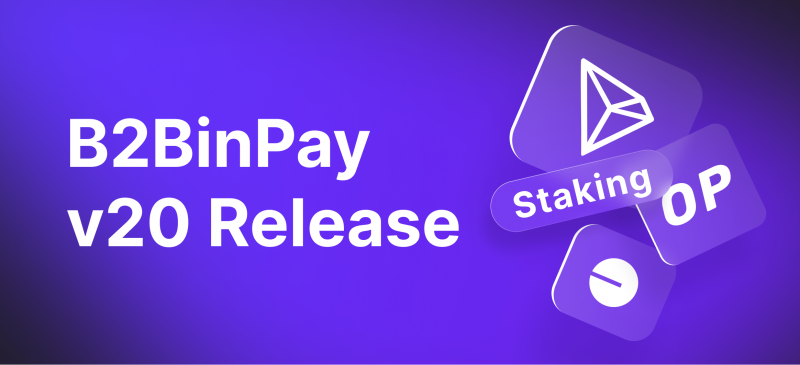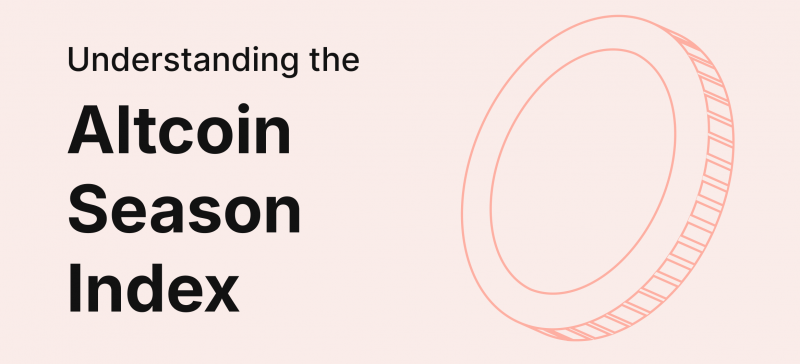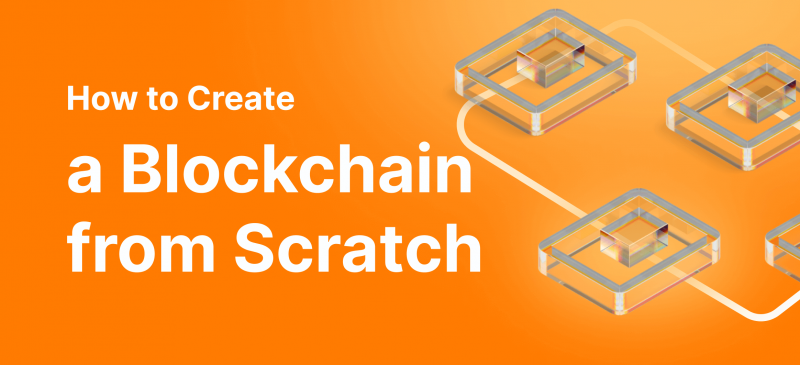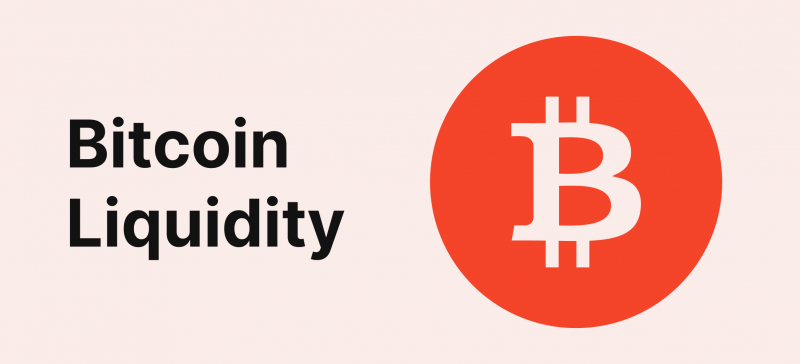A B2BinPay, a plataforma blockchain líder a nível mundial, acabou de ficar ainda melhor. A última versão inclui o staking TRX e expande o suporte blockchain, proporcionando maior flexibilidade e eficiência aos nossos clientes.
Revejamos como é que estes novos recursos melhoram a sua experiência com a B2BinPay.
Staking TRX Staking – Ganhe Enquanto Transaciona!

O staking é o processo de bloquear os seus criptoativos durante um período para apoiar a eficiência operacional de uma rede blockchain. Por sua vez, os stakers ganham criptomoedas adicionais como uma recompensa.
Na versão 20, introduzimos o staking TRX, potenciando o mecanismo avançado Stake 2.0 da comunidade TRON.
O staking TRX permite-lhe bloquear qualquer quantia de TRX e ganhar um rendimento passivo anual de 3 a 5%, consoante as condições da rede. Além disso, o staking TRX ajuda a reduzir os custos de transação na rede TRON convertendo o TRX participado em Largura de Banda e Energia — recursos vitais para o processamento de transações.
Para quem tem ativos disponíveis para proceder com a participação, esta atualização permite-lhe participar ativamente com estes e ganhar recompensas ao invés de deter esses ativos na sua carteira. O TRX está entre os ativos mais populares para o staking, com 28,12% dos TRX atualmente participados.
Caso não tenha TRX, não se preocupe. Desde a nossa 19ª versão, a B2BinPay tem suportado um recurso de Swap que lhe permite trocar instantaneamente as suas moedas por TRX, permitindo-lhe participar no staking e começar a gerar receita passiva imediatamente.
Carteiras de Staking
Nas carteiras, pode consultar as suas carteiras blockchain Enterprise denominadas em TRX. É fornecida a seguinte informação em relação a cada carteira:
Carteiras
A informação sobre a sua carteira TRX: o identificador da carteira, tipo (sempre E para Enterprise), etiqueta (se definida) e saldo total.
Recompensa Acumulada
A recompensa do staking que pode ser levantada.
Votos Disponíveis / Totais
Os votos Disponíveis are votes that haven’t yet been distributed among SRs (Super Representatives). The Total votes is the sum of distributed and undistributed votes.
Actions
Withdraw reward — clicking this button opens the Withdraw reward popup, where you can review withdrawal details such as a target wallet, withdrawal amount, transaction fee, and so on. Mind that reward claiming is available only once in 24 hours. The button is inactive if the Accumulated reward is 0 (zero) or the reward was claimed less than 24 hours ago. Get votes — clicking this button leads you to the Resources tab of the Wallet details, where you can stake TRX to get votes.
Get votes — clicking this button leads you to the Resources tab of the Wallet details, where you can stake TRX to get votes.

How TRX Staking Works at B2BinPay
TRX staking is a process of freezing funds for a certain period to get resources and additional profit. When you stake TRX, you can “exchange” your funds for resources like bandwidth or energy, which allows you to save on blockchain fees.
- Log in to your B2BinPay account.
- Review Staking Conditions – In the upper part of the page, review the TRX staking conditions, including the minimum staking period, the minimum amount of TRX required.
- Select Wallet – Go to the Wallets section and select your TRX wallet.
- Staking TRX – Click on the “Get votes” button. This will take you to the Resources tab of the Wallet details, where you can stake TRX.
- Assign Votes – For each TRX staked, you receive one vote. You can distribute these votes among producers in the TRON network also called super representatives (SRs).
- Claim Rewards – Once every 24 hours, you can claim the accumulated rewards.
- Unstaking TRX – To unstake your TRX, initiate an unstaking request. Remember, the unstaking process takes 14 days, during which your funds remain locked. You can cancel the unstaking request anytime during this period. When unstaking, all distributed votes are automatically cancelled, and the resources are no longer available.
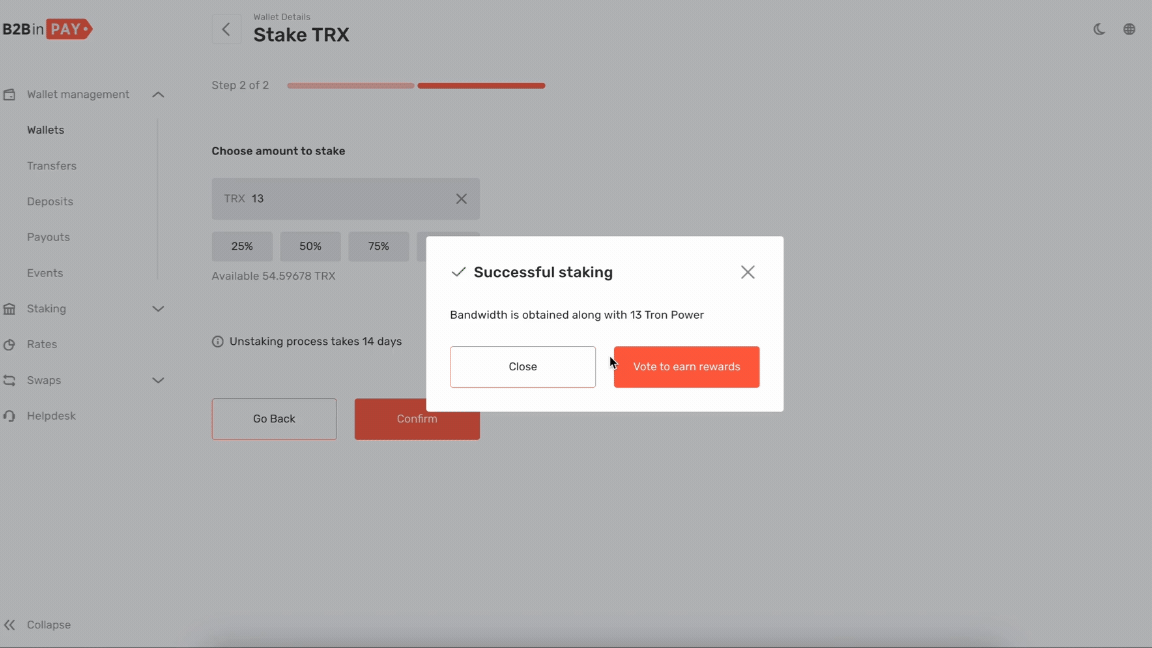
Staking into Resources
Stake your TRX in exchange for resources: Bandwidth or Energy. These resources allow you to save on the blockchain fees. The spent resources are replenished throughout the day.
Bandwidth is spent on TRX transfers and TRC-10 tokens, as well as partially on interacting with smart contracts. Having bandwidth enables you to conduct transactions on the TRON mainnet without incurring any gas fees.
Energy is spent on interacting with smart contracts and transferring TRC-20 tokens. This is a specialised resource for executing smart contracts on the TRON network. Smart contracts require Energy as well as Bandwidth, so ensure you have sufficient amounts of both when transferring your tokens!
Here are examples of 2 cases of how a B2BinPay client can efficiently stake TRX, covering the transaction fees:
Deposits Collection
B2BinPay Enterprise client spends ~95500 Energy and 345 Bandwidth on the TRON blockchain to collect a deposit from the end user’s deposit address into his own wallet. For each transaction, he irrevocably burns a commission of 41 TRX.
To purchase resources, you need to check the chart where it is indicated that 1 Energy = ~0.081 TRX, and 1 Bandwidth = ~0.893 TRX. Here’s how the client can avoid gas fees by staking funds to cover 1 collection transaction:
- Energy: 95500 Energy * 0.081 TRX = 7735.5 TRX
- Bandwidth: 345 Bandwidth * 0.893 TRX = 308.08 TRX
- Energy + Bandwidth = 7735.5 TRX + 308.08 TRX = 8043.58 TRX
So by staking 8043.58 TRX the client will avoid irrevocably spending 41 TRX for 1 deposit collecting to his wallet every day. Full payback of staking: 8043.58 TRX / 41 TRX = 196.18 days (6.53 months)
Withdrawal Fees Coverage
B2BinPay Enterprise client spends ~65000 Energy and 345 Bandwidth on the TRON blockchain to process 1 withdrawal of TRX. Or for each withdrawal operation, he irrevocably burns a commission of 28 TRX.
To purchase resources, you need to check the chart indicating that 1 Energy = ~0.081 TRX, and 1 Bandwidth = ~0.893 TRX. Here’s how he can avoid the gas fee by staking funds to cover 1 withdrawal:
- Energy: 65000 Energy * 0.081 TRX = 5265 TRX
- Bandwidth: 345 Bandwidth * 0.893 TRX = 308.08 TRX
- Energy + Bandwidth = 7735.5 TRX + 308.08 TRX = 5573.08 TRX
So, by staking 5573.08 TRX, the client will avoid irrevocably spending 28 TRX for 1 withdrawal every day. Full payback of staking: 5573.08 TRX / 28 TRX = 199.03 days (6.63 months)
Expanded Blockchain Support for USDT & USDC

It’s with great excitement that we announce the expansion of our supported blockchains to include Optimism, Arbitrum, and Base—each selected for their native support of stablecoins and their potential to offer you more cost-effective transaction processing options.
Optimism
- Market Cap: $2.7B
- 24-hour Trading Volume: $261.86M
- USDT Supply: $803M
- USDC Supply: $336.2M
Optimism, a Layer 2 scaling solution for Ethereum, significantly reduces transaction costs by batching operations. It aggregates transaction data from the Ethereum blockchain, processes it in groups, and submits it back to the mainnet for validation. This streamlined process slashes fees to a tenth of Ethereum’s usual rates. Launched in 2021, Optimism has already saved its users over $1 billion in gas fees, making it one of the most cost-effective blockchain options available.
Arbitrum
- Market Cap: $3.3B
- 24-hour Trading Volume: $377M
- USDT Supply: $2.38B
- USDC Supply: $1.18B
Arbitrum enhances Ethereum’s capacity for handling higher transaction volumes at lower costs. It utilises Ethereum’s existing tooling, which allows developers to deploy decentralised applications (DApps) quickly and securely. Its integration with stablecoins offers additional transactional flexibility for users.
Base
- Base is the 7th largest blockchain by total value locked
- 24-hour Trading Volume (Assets on BASE): $576.581.263
Developed by Coinbase, Base employs Optimism’s OP Stack to improve Ethereum Virtual Machine (EVM) compatibility. This open-source rollup not only supports stablecoins but also simplifies the deployment of code across Ethereum and its compatible blockchains, enhancing overall blockchain interoperability.

In our previous update, we expanded our offerings by including the Polygon and Avalanche blockchains. Now, with the addition of Optimism, Arbitrum, and Base, the list is bigger!
Currently, USDT is supported on 7 networks: Ethereum, Binance Smart Chain, Tron, Avalanche, Polygon, Optimism, and Arbitrum.
USDC is supported on 8 networks: Ethereum, Binance Smart Chain, Tron, Avalanche, Polygon, Optimism, Arbitrum, and Base.
Bridged USDC is supported on 4 networks: Avalanche, Polygon, Optimism, and Arbitrum.
Bridged USDC is used to transfer USDC across different blockchain networks via bridge protocols. These protocols lock USDC in a smart contract on the originating network and issue an equivalent amount on the destination network. You cannot directly bridge between Ethereum subnets, such as transferring from Arbitrum to Optimism.
This transfer must be routed through the Ethereum blockchain. Therefore, to move USDC funds from Arbitrum to Optimism, the following path is used: First – transfer funds from Arbitrum to Ethereum blockchain, Second – transfer from Ethereum to Optimism blockchain.
Click here to check the list of available cryptocurrencies.
Optimised Fees
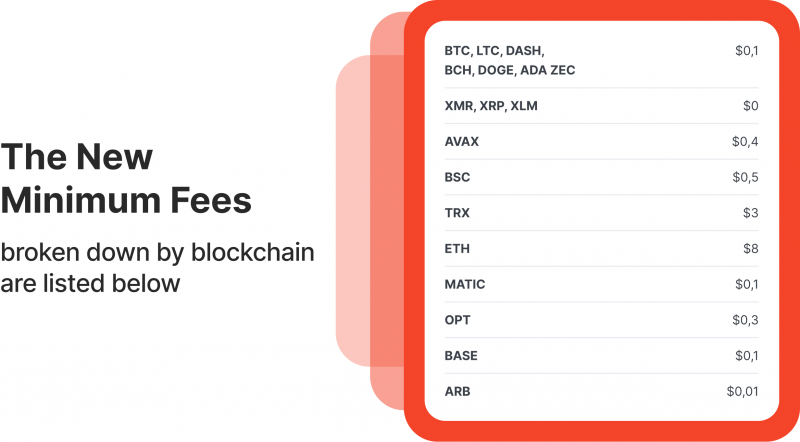
Important Note: The figures listed are the minimum commissions; there are no additional fees. If a transaction exceeds the specified minimum thresholds, the adjusted commission will apply.
For example, in case where the client is charged 0.25% for an incoming transaction in coins, the TRX Minimum fee equals 3$.
If 100,000 TRX is sent to the client, then the client will pay the amount of 250 TRX which approximately equals 27,98$. But if 1,000 TRX is sent to the client, then system we will apply the minimum fee of 3$, which is approximately 26,82 TRX.
Another example, where 1 ETH-ARB is sent to the client, then the client will pay the amoint of 0,0025 ETH-ARB which approximately equals $9,44.
However, if 0,001 ETH-ARB is sent to the client, then the client will not pay 0,0000025 ETH-ARB, as the system will apply the minimum fee of $0.01.
Please note that all changes come into force with the release on 17th June 2024. These updates are a part of our ongoing effort to offer superior and more convenient payment processing solutions. We are immensely thankful for your continued support and are excited to bring you more beneficial updates in the future.
Final Remarks
To sum up, our journey is ongoing. We’re planning to introduce Algorand and Solana in the next release. This expansion will increase the total number of blockchains supporting stablecoin transactions to ten, including our current platforms: Tron, Ethereum, Binance Smart Chain, Avalanche, Polygon, Optimism, Arbitrum, and Base.
Stay connected with B2BinPay and maximise your business potential with our advanced blockchain payment processing solutions!
